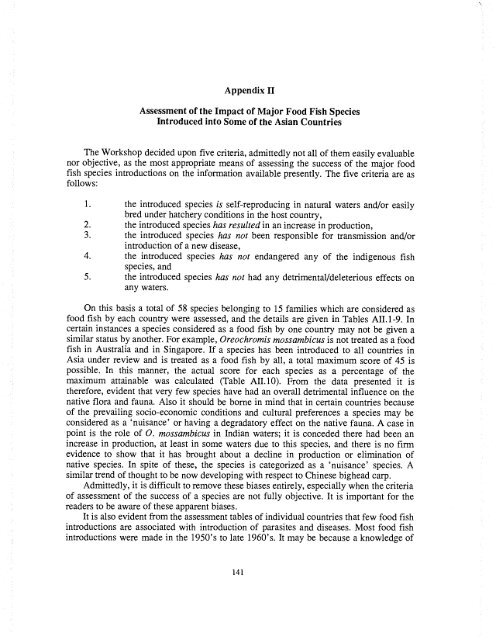Exotic Aquatic Organisms - International Development Research ...
Exotic Aquatic Organisms - International Development Research ...
Exotic Aquatic Organisms - International Development Research ...
Create successful ePaper yourself
Turn your PDF publications into a flip-book with our unique Google optimized e-Paper software.
Appendix II<br />
Assessment of the Impact of Major Food Fish Species<br />
Introduced into Some of the Asian Countries<br />
The Workshop decided upon five criteria, admittedly not all of them easily evaluable<br />
nor objective, as the most appropriate means of assessing the success of the major food<br />
fish species introductions on the information available presently. The five criteria are as<br />
follows:<br />
the introduced species is self-reproducing in natural waters and/or easily<br />
bred under hatchery conditions in the host country,<br />
the introduced species has resulted in an increase in production,<br />
the introduced species has not been responsible for transmission and/or<br />
introduction of a new disease,<br />
the introduced species has not endangered any of the indigenous fish<br />
species, and<br />
the introduced species has not had any detrimental/deleterious effects on<br />
any waters.<br />
On this basis a total of 58 species belonging to 15 families which are considered as<br />
food fish by each country were assessed, and the details are given in Tables All. 1-9. In<br />
certain instances a species considered as a food fish by one country may not be given a<br />
similar status by another. For example, Oreochromis mossambicus is not treated as a food<br />
fish in Australia and in Singapore. If a species has been introduced to all countries in<br />
Asia under review and is treated as a food fish by all, a total maximum score of 45 is<br />
possible. In this manner, the actual score for each species as a percentage of the<br />
maximum attainable was calculated (Table AII.1O). From the data presented it is<br />
therefore, evident that very few species have had an overall detrimental influence on the<br />
native flora and fauna. Also it should be borne in mind that in certain countries because<br />
of the prevailing socio-economic conditions and cultural preferences a species may be<br />
considered as a 'nuisance' or having a degradatory effect on the native fauna. A case in<br />
point is the role of 0. mossambicus in Indian waters; it is conceded there had been an<br />
increase in production, at least in some waters due to this species, and there is no firm<br />
evidence to show that it has brought about a decline in production or elimination of<br />
native species. In spite of these, the species is categorized as a 'nuisance' species. A<br />
similar trend of thought to be now developing with respect to Chinese bighead carp.<br />
Admittedly, it is difficult to remove these biases entirely, especially when the criteria<br />
of assessment of the success of a species are not fully objective. It is important for the<br />
readers to be aware of these apparent biases.<br />
It is also evident from the assessment tables of individual countries that few food fish<br />
introductions are associated with introduction of parasites and diseases. Most food fish<br />
introductions were made in the 1950's to late 1960's. It may be because a knowledge of<br />
141

















